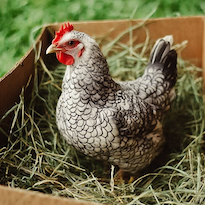The Fairies
Click on the thumbnails for a big version
Hobin (Books 1 - 3)

Hobin is a boggart. In fairy tradition, boggarts are mischievious house fairies, while brownies are helpful house faires. In the Fairy Rescue League, boggarts are male and brownies female versions of the same kind of house fairy, they can both be very helpful, or a royal pain.
Hobin's rules - that you're not allowed to see him or reward him - are very much traditional fairy taboos.
Holly (Books 1 - 3)

Holly is very self-satisfied brownie who can use the word 'dear' to mean more things than any other word in the English language.
Holly maintains the same traditional taboos as Hobin - which in her case translates into boys not being allowed in the kitchen. She's a little less traditional about not being seen, especially if it might interfere with accessing cream cakes.
Gunna (Books 2 & 3)

Traditionally, Gunna is a Scottish fairy, as in the books, who wore nothing but a fox skin and whose mission was to protect his cattle. He is thin, cold and hungry, but is not traditionally a child.
Here, our Gunna appears very determined. Perhaps he is considering how to revenge himself on Granny. He's also done something about the cold by putting on a fox fur jacket to match his kilt.
Granny Goggie (Books 1 - 3)

The original of Granny was Awd Goggie, a Nursery Bogle (as Granny proudly tells Adam she is) whose role in life was to scare off scrumpers. I don't know if Awd Goggie was as partial to alcohol as Granny, but given he protected orchards, we can assume he was partial to cider, at least.
The Brown Man (Book 1)

The Brown Man (of the Moors) is part of the (North of England) fairy tradition. A nature spirit, he is guardian of the wild beasts and the wild in general. Aside from his dislike of windmills (as encroaching on nature), he appears in the first book in very much his traditional form.
The Ghillie Dhu (Book 2)

The Ghillie Dhu is a Scottish version of the Brown Man. Again, the Ghillie Dhu appears in The Wildwood very much in his original form, but with some elaboration.
The Ghillie Dhu is credited with rescuing lost children in fairy lore, so his 'adoption' of Gunna is entirely in character.
Earl Greenleaf (Book 3)

Diminutive fairies like Earl Greenleaf were something of an Elizabethan invention - which is why the Earl and his people are dressed as (and speak like) Elizabethans.
The green clothing and red hat/feather are nods towards older fairy traditions, and especially the fairies known as Red Caps.
The Natural History Of A Book Cover
Matt Smith at Shimuzu put in an enormous amount of work to create a cover for The Fairy Rescue League. It was very hard to choose which one to use, and in the end it came down to something as simple as: which one worked best in the small thumbnail size on Amazon. Below are three different versions of the cover which we didn't get to use.
Initial Version
This first one is inspired by a scene in the book - but sadly it didn't work as well at a small size. I still like it, though.










